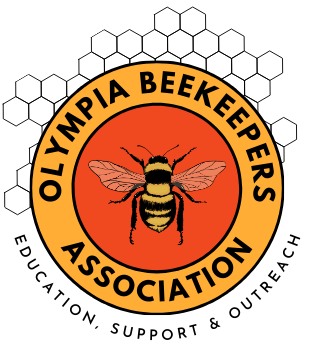28 people in attendance; 24 in person, 3 online
Welcome new members!
- Vice President: Nathan Allan
- If things come up in the legislative session related to bees, we’ll try to keep the association informed so we can advocate for bees
- Treasurer: David Bruun
- Checking – $5,234.28; Savings – $4,584.15
- OK to pay Nathan $125/month for 2024 meeting location? Also covers apprenticeship class location. – YES!
- Farmers Market by Steamboat Island and another by Steilacoom – Anyone want to sell their honey? We will buy it from you at wholesale and sell at market rate (last year was $6 to buy and $10 to sell at market)
- Secretary: Camy Naasz
- Check out the refreshed website! olympiabeekeepers.org
- Complete the 2024 planning survey by Jan 10th
- Education Coordinator: Gail Booth
- Need to set a date for apprenticeship class
- Alan Woods is starting up a journeyman’s class, Deb volunteered do a journeyman class
- Membership Coordinator: (vacant) – Christina volunteered and we all approve!
- Librarian: Lynn Phillipi
- Go ahead and check out from the library – please put name and phone number on the card, OK to keep for 2-3 months, when return it, please give to Nathan so he can return the card to the book
- During meetings, Saturday and Sunday between 8-noon, or give Nathan a call at other times during the day
- If there is a beekeeping book you want and we don’t have, talk to Lynn so she can purchase it for the library with this year’s budget
- Mentorship: Bryan – looking for mentors, will be talking to 2nd year beekeepers to be mentors for beginners
- Special guest speaker: Danny Najera, PhD – Green River College (Auburn, WA) – 10 years of honey bee research
- 10 years of honey bees on campus (2013-2023) – originally funded by a gift from Bob Rivers
- Bottom board mite counts are highest/higher than threshold in Sept, Oct, and Nov (sugar shake tests will show higher counts earlier)
- Described a study of 100 hives and variables related to winter loss
- colony size, entrance height, hive weight, humidity, Nosema spores – no obvious trend, these do not affect winter loss
- Varroa mites – the only thing statistically significant was the mite count going into winter – below about 7 mites and hives will get through winter, above the line and they will not
- Suggested to have the association own an oxalic acid treatment system and loan it out to members
- Study to see what would control mites AND get more honey – isolation (brood break) increased honey yield and mite counts! (Pollen foragers switch to nectar.) Formic acid DECREASED the amount of honey and mite counts. When no more brood, mites grab onto foragers and colony becomes very contagious. Treating for mites once out of the brood cap is so much easier (phoretic mites). SO, if you isolate and treat with oxalic acid, good be a really good solution. Best time to do an isolation is a few weeks before the dearth.
- It’s really hard on the bees to not treat at all – highest loss over winter
- Winter mortality rates haven’t decreased in the last 10 years (still 40%) because there are not enough beekeepers doing the work to treat and because so many bees are shipped and super consolidated around the country throughout the year contaminating each other – it’s a systemic issue.
- Small hive beetle now documented in the area – look, pay attention, will see it
- Can fly 1-2 miles
- Contaminate honey – changes it into gooey, yeasty stuff that is bad for bee and human consumption
- Check for them by putting the lid under the box and shining a light down from the top, they will run from the light and end up on the lid
- They pupate in the soil around the colony – make sure it’s not good for the larvae
